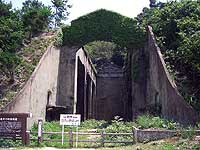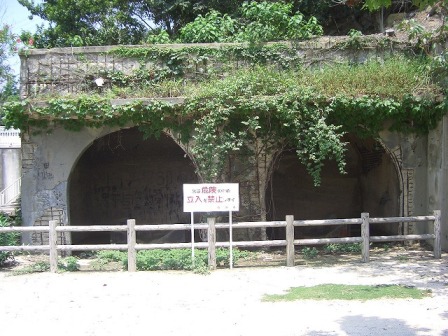Okunoshima: poison gas past belies isle’s bucolic serenity
By Eric Johnston
OKUNOSHIMA, Hiroshima Pref. — With its turquoise waters, quiet forest paths, palm trees and spectacular views of the mainland and other islands of the Inland Sea, Okunoshima Island has the feel of a resort somewhere in the Aegean Sea or the South Pacific.

1. The ruins of a poison gas factory on Okunoshima. Photos courtesy of Yamauchi Masayuki
Every hour, the ferry from Honshu disgorges another group of people looking for a quiet beach vacation. Children and their mothers splash in the swimming pool or head to the beach, while others browse the gift shop at the hot spring resort.
But closer scrutiny of this idyllic scene finds something sinister. Crumbling, half-hidden concrete structures dot the island, and smashed-up machines of concrete and ceramic litter the trails. These are all that remain of Okunoshima’s past as a military installation that produced thousands of tons of poison gas.
“From 1929 to 1945, the (Imperial) Japanese Army produced five types of poison gas on Okunoshima,” said Yamauchi Masayuki, a former educator and one of the leaders of a volunteer organization that gives tours of the poison gas facilities.
“The island was so secret that it was ordered removed from area maps and local residents were warned to keep quiet about what went on here.”
During the early 20th century, Okunoshima was a major garrison. After World War I, when mustard gas was used to kill or maim thousands in Europe, Japan embarked on its own chemical weapons program.
Okunoshima was chosen as the main production site for several reasons.
First, it was far enough away from heavily populated areas that deaths would be minimized in the event of an accident.
Second, it was close enough to military installations near Hiroshima and Kure in Hiroshima Prefecture to appeal to the top brass.
Third, after the Great Kanto Earthquake of 1923 destroyed chemical weapons plants in the Tokyo region, the military realized it would be less expensive to build new ones on Okunoshima than to rebuild the sites in Tokyo.
When production began in 1929, priority was given to mustard gas. Nerve gases and diphenylchlorarsine, or “sneezing gas” because it blocks the body’s ability to absorb oxygen by inducing constant sneezing, were also produced.
“Workers were local residents who were very happy to be working for good wages,” Yamauchi said. “Former workers have testified that they did not know the names of the gases they were producing and simply referred to them by their color: yellow for mustard gas, red for sneezing gas.”
Over the roughly 16-year period the factories were in operation, an estimated 6,500 workers were employed at dozens of buildings on the 70-hectare site, according to Japanese historians.
They were involved in all aspects of production, from making the gas to putting it in shells. Although no official statistics exist, many became ill and suffered respiratory problems for the rest of their lives.
Some were also involved in accidents, and became horribly disfigured when the arsenic in the mustard gas penetrated their bodies and created bubbles under the skin. About 3,200 former workers are still alive.
By the end of the war, thousands of tons of gas and untold numbers of shells had been produced on Okunoshima.

2. Storage Facilities for poison gas.
But in the postwar years, little was known nationally of the island’s history. Only in the mid-1980s, when archival materials related to Okunoshima were found, did Japanese historians conclude that just over 6,000 tons of gas were produced on the island between 1929 and 1945.
Much of the gas went to China, where it was used against both Chinese Nationalist and communist forces fighting the Japanese occupation of China and Manchuria.
Chinese historians say some 10,000 people were killed in over 2,000 gas attacks carried out by Japanese forces between 1931 and 1945. Today, unexploded shells continue to surface in China.
By 1944, with the war going badly for Japan, many of the male workers on Okunoshima were drafted into the military. But gas production continued, as over 1,000 local schoolchildren, some as young as 14 and including many girls, were pressed into the war effort.
“They did the most dangerous jobs, including storing the poison gas shells and cleaning up the factory floors,” Yamauchi said.
“Many fell ill and remained in poor health for the rest of their lives.”

3. Museum exhibit shows gas masks
When the war ended, first American, and then a joint British-Australian contingent of troops, landed on Okunoshima as part of the Occupation.
They arrived to find workers had burned many of the documents and smashed up much of the equipment, some of which remains on the now overgrown forest floor six decades later.
“None of the military leaders in charge of Okunoshima’s poison gas program was charged as a war criminal,” Yamauchi said. “The Americans questioned the leaders but kept the research for themselves.”
Although the few remaining structures are rapidly disappearing due to man and nature, the island’s poison gas legacy is not over.
In 1996, the local water supply was discovered to have been contaminated with arsenic. In June, the Environment Ministry reported finding arsenic levels 49 times the environmental standard at one location on the island.
Since 1998, whenever arsenic-tainted soil was discovered, it has been removed and sent to Akita Prefecture for decontamination.
However, as Yamauchi notes, the central government has turned a deaf ear to repeated requests to seek out and remove not only the arsenic, but the remaining gas on the island.
“There are about 11 sealed-up locations on Okunoshima where workers say they buried gas when the war ended,” he said. “But Tokyo refuses to do a thorough cleanup because Okunoshima and Japan’s poison gas program are still taboo subjects.”
This article appeared in The Japan Times: Aug. 11, 2005. Eric Johnston is Deputy Editor of The Japan Times and is based in Osaka. His book, “Japan’s Nuclear Nightmare: Power to the People?” will be published by Parlor Press in the United States later this year. Eric can be reached at [email protected] Posted at Japan Focus on August 12, 2005.



